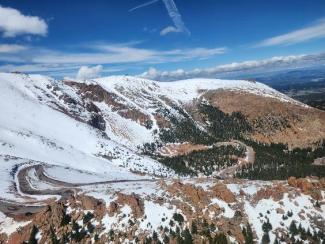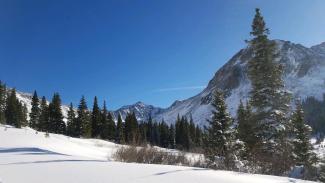Brave the Elements
The Rocky Mountains attract millions of visitors each year to go mountain hiking, climbing, camping, fishing, boating and more. Weather conditions and altitude can pose risks to recreationalists.
Lightning strikes can be preventable!
Be aware and take steps to lower your risk of being struck.
- If you are caught above the tree line when a storm approaches, descend quickly. Avoid isolated trees. It is better to run into a forest.
- Electric storms can also develop in the middle of the night. To lower your odds, don't pitch your tent near the tallest trees in the vicinity.
- Drop metal objects like hiking poles, fishing poles and packs with internal or external metal frames.
- Get off motorcycles, ATVs, bicycles, boats and horses. Metal fences and utility poles are also to be avoided.
- If you are caught in an open field, seek a low spot. Crouch with your feet together and head low.
- Don't sit or lie down because these positions provide much more contact with the ground, providing a wider path for lightning to follow. If you are with a group, and the threat of lightning is high, spread out at least 15 feet apart to minimize the chance of everybody getting hit (see "What should you do if someone is struck by lightning?").
- Don't return to an open area too soon. People have been struck by lightning near the end of a storm, which is still a dangerous time.
Summer thunderstorms pose a threat to your safety in the backcountry.
- Descend to tree line by noon. Plan trips to descend from high elevations to avoid afternoon thunderstorms above timberline. When skies begin to look threatening, they already are. Anytime clouds develop vertically and cloud bases grow dark, a lightning hazard exists, even before you hear thunder or see lightning.
- Monitor approaching storms on the horizon as well as thunderstorm development overhead or nearby. Lightning bolts can strike 10-15 miles out from a thunderstorm.
- Seek cover in a building or vehicle (if possible). That means a substantial building (not picnic shelters, bus stops, dugouts, etc.) or inside a metal, covered vehicle (not open jeeps or ATVs ). If inside a vehicle or building, don't touch anything that could conduct electricity.
What should you do if you are caught out in the backcountry during a thunderstorm?
- Retreat from highly exposed areas quickly. Minimize the chance of a direct hit; don’t be the tallest object in the vicinity. Lightning often seeks higher objects because it's a shorter gap for the electrical charge to bridge, so being near a single tall tree or group of tall trees in an opening is also dangerous. Move into a stand of smaller trees in a lower position on the landscape to increase the odds that lightning will strike higher points or taller objects instead.
- Squat down with your head on your knees, feet and legs together, and balance on the balls of your feet. The majority of lightning strikes are not direct hits, but rather arc from another object or through the ground after a nearby strike. Dangerous ground currents can reach out up to 100 yards from the object that is struck. Minimizing your contact with the ground will minimize the likelihood of being hit by a ground arc.
- Spread out! In dangerous situations, it's advisable for groups to separate, not huddle together. If a ground arc hits one person, it will probably affect everyone nearby. By spreading well out, you reduce the odds of everyone being hit.
- Avoid objects that conduct electricity, like water channels or metal fencing. Lightning can follow streams or barbed wire fences for long distances, flow into the ground and spread out.
Even when a thunderstorm is far away or has already passed over, lightning danger may remain.
While most lightning strikes originate from the negatively charged lower levels of a thunder cloud and bridge the gap to corresponding positive charges on the ground, far more powerful strokes can originate from the positively charged upper portions of a cumulonimbus cloud, extending for miles into clear air (often behind the thunderstorm) and angling to the ground many miles from the storm itself. Because of the much greater gaps these positive strokes bridge to corresponding negatively charged ground objects (including people), they are much more powerful. A thunderstorm may have passed, the sun is out and the sky is blue, so you're back to play or work. Wham! Likewise, such strokes can precede a storm by miles for the same reason.
On the water—Swimmers, anglers and boaters should get off lakes or rivers and seek shelter when storms approach. Drop any fishing rods. Boaters who cannot get off the water before the storm hits should crouch low. Once on land, get at least 100 yards away from shore.
What should you do if someone is struck by lightning?
People who have been hit by lightning carry no electric charge and can be safely tended to. Also, victims who appear dead can often be revived. If the person is not breathing, begin mouth-to-mouth resuscitation. However, if a pulse is absent as well, and you know cardiopulmonary resuscitation (CPR), begin CPR. Stay with the victim until help arrives.
Remember: This information is not intended as a substitute for medical treatment. If you have a health-related concern, consult a physician. Also, the tips discussed here may lower injury risk, but the unpredictability of lightning affords no guarantees.
For more information on the subject of lightening behavior and safety, check out the National Weather Service's Lightning Safety Tips and Resources.
The mountains of Colorado are among America’s most beautiful, and we hope that you will enjoy every minute of your visit. However, some of the very features that make the high country so attractive may cause problems unless you recognize their dangers and know how to prevent them.
As you go higher, barometric pressure decreases, the air is thinner and less oxygen is available. It’s also colder and drier, and the ultraviolet rays from the sun are stronger. Each of these changes may have unpleasant effects on your body.
There is great personal joy, beauty and inner peace to be discovered in the mountains. Treat yourself with respect and enjoy your visit.

View of Pikes Peak from a helicopter
U.S. Forest Service photo by Steven MannAltitude
You may notice that your breathing is faster or deeper, and you may feel short of breath, especially when you exercise. This is the body’s first and most effective response to altitude. Your heart is likely to beat faster also; this, too, is a helpful, normal reaction.
However, you may also develop a headache, slight nausea or unusual tiredness; some people even have trouble sleeping. Depending on the altitude, 20% to 30% of all visitors from near sea level have one or several of these symptoms. We call this acute mountain sickness or AMS. Children are more susceptible than adults.
Mild symptoms include headache, nausea, poor appetite, run-down feeling and shortness of breath with exertion. If symptoms remain after a day or two, grow worse or worry you, consult a doctor. If you develop a worsening cough, increasing shortness of breath or feel like you have fluid in your lungs, see a doctor at once!
Before you leave home, you can do a few things to decrease the effects of altitude. Spending two nights at a modest altitude decreases symptoms when you go higher. Eat foods which are high in carbohydrates, drink more water, take less salt and avoid alcoholic beverages.
Once you arrive, take it easy for the first day or two. Reduce alcohol, caffeine and salty foods. Drink more water than usual. Salt causes your body to retain fluid (edema) which increases the severity of altitude illness. Some have found that chewing Rolaids may help.
Listen to your body! Altitude illness feels very much like flu or a hangover but is much more serious. Don’t push. If you feel worse and worse, get medical help! Minor altitude symptoms occasionally become life-threatening. Don’t let ignorance or carelessness spoil your stay!
Acclimation Tips
- Increase fluid intake
- Decrease salt intake
- Moderate your physical activity
- Select high-carbohydrate foods
- Eat low-fat meals
- Reduce alcohol and caffeine
- Feeling lousy? Seek help!
- Have fun!

Be responsible: Your safety and the safety of others around you is your primary responsibility. What you wear, where you go, the equipment you carry and how you conduct yourself is vitally important.
Be avalanche savvy: Know the conditions present for an avalanche. Take a certified avalanche course. Find courses at Avalanche.org.
Be aware: Know the avalanche danger/conditions where you will be recreating. Heed all warnings.
Be prepared: Everyone in your party should have at least these three safety items with them at all times along with a backpack and a partner. Know how to use the rescue tools and the purpose of all five necessities below.
- Avalanche transceiver: Know the terrain and avoid dangerous conditions. If you are caught in an avalanche, use your avalanche transceiver to help others in your party find you.
- Avalanche probes: These collapsible poles are longer than ski poles and are the perfect tool to begin searching for someone buried under the snow.
- Shovel: Each person in your party should carry a shovel. Shovels can help you dig others out who may be caught in an avalanche, help determine snowpack conditions, assist in leveling out an area for a tent or be used to melt snow for drinking water. Watch a video about how to use your rescue tools.
- Backpack: Your pack should hold all your rescue gear, food, water, dry clothing, first-aid kit and other items.
- Partner: None of the above pieces of equipment will help you if you venture into the backcountry alone—always bring a buddy.
Find more information at the Avalanche Center.
Remember: You are responsible for the safety of yourself and for those around you.
The human body is great at cooling itself through natural mechanisms, but extreme heat can overwhelm the body, resulting in heat-related illness.
Heat-related illness can include the following:
- Heat cramps
- Heat exhaustion
- Heat stroke
Older adults, young children and people with chronic medical conditions are at high risk for heat-related illness. Hundreds of people in the United States die every year of heat-related illness.
When you visit your national forests and grasslands, take the extra time to protect yourself and others from heat-related illness.
- Drink plenty of water. Avoid sugary drinks and alcohol, as they can lead to dehydration.
- Stay in the shade whenever possible.
- Schedule the most rigorous activities for early or later in the day.
- Wear lightweight, loose-fitting, light-colored clothing.
- Keep a close eye on older adults, children and those with chronic medical conditions.
Heat Exhaustion
Symptoms
- Heavy sweating
- Weakness
- Cold, pale, clammy skin
- Fast, weak pulse
- Nausea or vomiting
- Fainting
What to do
- Move to a cooler location.
- Lie down and loosen clothing.
- Apply cool, wet cloths to as much of the body as possible.
- Sip water.
- If vomiting occurs and continues, seek medical attention immediately.
Heat Stroke
Heat stroke is a medical emergency. If you suspect heat stroke or see the signs below, call 911 immediately.
Symptoms
- High body temperature (above 103°F)
- Red, hot, dry or moist skin
- Rapid, strong pulse
- Unconsciousness
What to do
- Call 911 immediately.
- Move to a cooler environment.
- Reduce body temperature with cool cloths or with a cool bath.
- Do NOT give fluids.



